Abstract
Background
Improving organ donation rates requires better detection of possible organ donors, which in turn necessitates identifying barriers preventing the identification of possible organ donors. The objectives of this study were to determine the actual rate of possible deceased organ donors among nonreferred cases and to identify barriers to their identification as possible donors.
Methods
This retrospective observational study used 6 months of data collected from two intensive care units (ICUs). Possible organ donors were defined as patients with a Glasgow Coma Scale score <5 and evidence of severe neurological damage. Barriers that led to the nonidentification of these patients as possible organ donors were also identified.
Results
Fifty-six of 819 patients admitted to the ICUs during the study period were detected as possible organ donors, representing a 6.83% possible organ donor detection rate. Nonclinical barriers to the identification of possible organ donors were found to be more significant than clinical barriers (55% vs. 45%, respectively). The most significant nonclinical barrier was an unknown reason, despite patients being medically suitable for deceased organ donation and fulfilling the criteria for possible organ donor classification. Unresolved sepsis was the main clinical barrier.
Conclusions
The significant rate of unreferred possible deceased organ donors found in this study reveals the need to increase awareness and knowledge among clinicians of the proper detection of possible donors at an early stage to avoid the loss of possible deceased organ donors, and thereby increase the deceased organ donation rate in Malaysian hospitals.
Transplantation is the only form of definitive treatment for various types of end-stage organ failure [1]. However, the imbalance between the supply and demand of organs for transplantation is a major issue facing society [2]. Ethical concerns, a lack of understanding and awareness, and mistrust in the system pose difficulties in reducing the organ supply-demand imbalance [3].
Spain has achieved the world’s highest rate of deceased organ donation, having reached 35.9 donors per million population in 2014 and 49.6 donors per million population in 2019 [4]. Those data are based on the Global Observatory on Donation and Transplantation database [5], produced by the World Health Organization (WHO) and the Spanish Transplant Organization (ONT) collaboration. Organization around the process of deceased donation was the key to success of the Spanish system. A critical pathway has been developed by a diverse, multicultural, and multi-regional working group convened through the support of The Transplantation Society, the ONT, and the WHO [6]. Fig. 1 describes the process of organ donation from deceased persons defined in this project.
In the donation after brain death (DBD) pathway, the starting point of deceased organ donation is the detection of a possible deceased organ donor (i.e., a possible DBD donor), defined as a patient with a devastating brain injury or lesion. When a possible DBD donor’s condition is suspected to fulfil the criteria for brain death, the patient becomes a potential DBD donor. A potential DBD donor would become an eligible DBD donor if the person were considered medically suitable for organ donation and is declared dead based on neurologic criteria, as stipulated by the law of the relevant jurisdiction. An eligible DBD donor would become an actual DBD donor only after the consented eligible donor has undergone an operational incision with the intent of organ recovery for the purpose of transplantation [6,7]. This approach has been totally or partially replicated by other countries and regions, resulting in a progression in the pursuit of self-sufficiency in transplantation [4]. Reducing the imbalance will involve a multifaceted approach, including increasing the donor pool, educating professionals and the public, and a focus on alternative options to human transplantation [3]. The medical suitability criteria for identifying patients as potential organ donors are extensive [8]; contraindications include unresolved septicemia at the time of death, active tuberculosis, human immunodeficiency virus (HIV), and active malignant cancer.
Malaysia began its donation and transplantation program in the early 1970s. It initially began with living related kidney transplants in 1975, followed by kidney transplants from deceased donors in 1976. The deceased donation program formally began in 1997 with the establishment of the National Transplant Resource Centre and recorded a total of 733 deceased donors through October 2020, according to the official website of the National Transplant Resource Centre [9].
In Malaysia, solid organs are mainly procured from donors after brain death. Brain death diagnosis is usually performed in the intensive care unit (ICU) of hospitals. One of the ways to increase the donor pool is the early identification of possible donors in the ICU. Identification of a possible deceased donor and referral by the treating physician to a key donation person/organ procurement organization should ideally occur as early as possible, particularly when referring a person with a devastating brain injury or lesion. Referral requires, and is linked to, the act of identification [10].
At Hospital Sultanah Aminah, Johor Bahru (HSAJB) and Hospital Queen Elizabeth, Kota Kinabalu (HQEKK), the key coordinating unit for processing organ donations is the Unit Perolehan Organ Hospital (UPOH). However, no proper protocol exists for detecting possible organ donors in the ICUs; therefore, some cases are referred to the UPOH at a later stage, such as after brain death certification or cardiac arrest.
This study aimed to (1) determine the rate of detection of possible deceased organ donors among the patients admitted to the ICUs who were not identified and referred as possible organ donors and (2) identify the barriers to identification of possible deceased organ donors that lead to nonreferral to the organ coordinators. The identified barriers were categorized into clinical and nonclinical types. Based on the data and analysis obtained from this study, we hope to develop a protocol that includes the proactive identification, monitoring, and referral of possible deceased organ donors.
This research was approved by the Malaysian Medical Research Ethics Committee (MREC; Ref No. NMRR-21-325-58752 [IIR] for the study protocol version 2.0 dated March 25, 2021). Due to the observational and retrospective nature of the data collection, the MREC waived the need for consent for data collection.
This was a cross-sectional study using retrospective data collected from all patients admitted to the ICUs of HSAJB and HQEKK from August 2020 to January 2021 who had fulfilled the inclusion and exclusion criteria. Based on the 2017 Malaysian Registry of Intensive Care, HSAJB and HQEKK had 694 and 768 ICU admissions, respectively, in 2017 [11]. Both hospitals are major hospitals in their respective states and house neurosurgical and trauma centers. Their ICUs receive mixed admissions of general medical cases as well as surgical, including neurosurgical, cases.
The sample size originally targeted 60 participants for the possible deceased organ donor pool; however, we were only able to identify 56 possible donors who were not referred as possible organ donors to the organ donation coordinator out of a total of 819 admissions to the two ICUs during the study period. Consecutive sampling was used in both ICU databases. Patient enrollment into the study was based on ICU admission and referral forms. The medical records of all possible donors identified were reviewed to evaluate the patient’s condition and organ donation activity according to the critical pathways for organ donation.
This study involved all patients admitted to the ICUs of HSAJB and HQEKK as the denominator and the study group—consisting of those with severe neurological damage and a Glasgow Coma Scale (GCS) score <5—as the numerator for the calculation of the possible deceased organ donor rate. The inclusion and exclusion criteria for this study were as follows. Inclusion criteria: (1) admitted to the ICUs of HSAJB and HQEKK during the study period, with a GCS score <5 on ICU admission and persistently <5 during ICU admission while not on sedation; (2) GCS score >5 on ICU admission but <5 persistently during ICU admission while not on sedation; (3) had severe neurological damage on ICU admission; (4) not referred to organ procurement coordinator as a possible organ donor. Exclusion criteria: no exclusion criteria.
The patients identified and enrolled in this study were those who were identified as possible organ donors but not referred to the organ procurement coordinator. Patients’ clinical case notes were examined, and the reasons indicated for nonreferral were identified as barriers to the identification and referral of patients as possible organ donors. The main barriers to organ donation were identified and divided into two major categories: clinical and nonclinical barriers. Clinical barriers were identified from patients’ case notes that indicated clinical reasons for nonreferral, including unresolved septicemia at the time of death, sepsis and/or multiorgan failure, active tuberculosis, active viral infection, infection or positive serology for HIV, active fungal infection, systemic diseases (collagenosis, vasculitis), cardiac arrest before medical evaluation, generalized arteriosclerosis, oncologic/hematologic diseases or malignancies, and intravenous drug abuse or other risk factors.
Patients who did not have any apparent clinical reason for nonreferral, were labelled as “not reported as a possible donor despite fulfilling the criteria of a possible donor.” For patients documented as having loss of all cranial nerve reflexes in addition to severe neurological brain damage and GCS score <5, for whom no formal brain death testing was done, the barrier was identified as “brain death testing was not done.” Other nonclinical barriers to the identification of possible organ donors were as follows: logistical problems, lack of an appropriate recipient, no identifiable relatives/relatives not contactable, relatives’ refusal of permission for organ donation, and no magistrate clearance for organ donation.
Once a patient was identified as a possible deceased organ donor, he or she was enrolled in the study. A case report form was used to collect additional data, including age, sex, and whether the patient was successfully converted into an actual organ donor. Next, further information was obtained regarding the existence of any clinical or nonclinical barriers that prevented patients from being detected as possible organ donors. The statistical analysis was performed using Microsoft Excel (Microsoft Corp.) and IBM SPSS ver. 21 (IBM Corp.).
A descriptive analysis was conducted to describe socio-demographic data (age, sex). Numerical variables were analyzed using means with standard deviations. Percentage and frequency were used for categorical variables and expressed as medians with interquartile ranges.
The rate of possible deceased organ donors at the two ICUs during the study period was calculated as the total number of enrolled patients (i.e., those identified as possible donors; the numerator) out of the total number of patients admitted to the two ICUs during the study period (the denominator).
To identify the major clinical and nonclinical barriers, the data collected were tabulated and presented as a pie chart in Microsoft Excel depicting which barriers were the most significant in preventing the conversion of possible donors into actual donors among the enrolled participants.
Fig. 2 presents the enrolment process for determining inclusion or exclusion in the retrospective study to detect the possible organ donor rate. All of the subjects in this study fulfilled the inclusion criteria and had been admitted to the ICU over the 6-month period from August 2020 to January 2021 in HQEKK or HSAJB.
There was no official referral to the hospital’s organ donation coordinator during the 6-month data collection period. In other words, none of the patients detected as possible organ donors in the two ICUs were identified as such and thus none were referred. In comparison, a total of 56 patients who fulfilled the possible organ donor criteria, including clear evidence of severe neurological damage obtained via imaging and preintubation and a GCS score <5, were retrospectively detected among the ICU admissions of the two hospitals over the course of the 6-month data collection period, representing a 6.83% chance of detecting a possible organ donor among the patients admitted to the ICUs (Fig. 2).
Table 1 shows the breakdown of the enrolled patients according to hospital. The patients who were detected to be possible deceased organ donors had a mean age of 54.5 years, with males accounting for almost two-thirds of the total patients enrolled. More patients were detected to be possible organ donors from HSAJB compared to HQEKK; however, HQEKK was found to have a higher percentage of possible organ donors than HSAJB (7.9% vs. 6.1%, respectively) (Table 1).
Unfortunately, there were no actual organ donors converted during the 6-month retrospective study period; thus, the donor conversion rate was 0%.
No referrals were made to the hospitals’ organ donation coordinator during the study period. Thus, the barriers shown in Fig. 3 are specifically the barriers to the referral of ICU patients to the organ donation coordinator as possible organ donors, representing the loss of potential organ donors at an early stage of the deceased organ donation process. Based on the data collected, nonclinical barriers predominated among reasons for the nonconversion of possible donors into actual donors (55%).
As shown in Fig. 4, among the clinical barriers, sepsis, or uncontrolled bacterial or viral infection, was identified as the main clinical barrier to possible deceased organ donor conversion, detected in 15 of 25 cases. Other clinical barriers identified were oncologic/hematologic diseases or malignancies (4 cases), HIV positivity (3 cases), known history of drug abuse (2 cases), and active tuberculosis (1 case).
More cases had nonclinical barriers to the conversion of possible deceased organ donors than had clinical barriers, as shown in Fig. 5. Throughout the 6-month study duration, no brain death testing was done for any patient in either ICU. A majority of the nonreferred patients had unknown reasons for the lack of referral; the researcher was unable to identify an actual reason in the patients’ case notes for the nonreferral of 23 of the cases. Among reasons that could be identified, brain death testing was not done in three cases with overwhelming evidence of brain death, leading to the nonreferral of those three cases. The inability to get the family involved in order to proceed with brain death testing was another significant barrier, or cause for nonreferral; four cases had logistical issues with getting the family members to come to the hospital, and in one case, no family member was able to be identified.
Organ donation is often considered the greatest act of life—the best gift that one can give to another person—but in reality, at least in Malaysia, organ donation is not at an adequate level to keep up with the burden of chronic organ failure, especially chronic renal failure. Thus, in order to ease the supply-demand imbalance, it is critical to increase the detection rate of possible organ donors, especially in the early stage of the pathways for organ donation (i.e., in the ICU), which has the greatest likelihood of producing possible deceased organ donors.
Our study found that 6.83% of all patients admitted to the two ICUs in this study were possible deceased organ donors that were never referred, equivalent to almost seven possible deceased organ donors per 100 ICU admissions during the study period, all of which were losses at an early stage because they were not identified in the ICU and thus not referred to the hospital’s organ donation coordinator. A possible deceased organ donor is defined as a patient with a devastating brain injury or lesion or a patient with circulatory failure and apparently medically suitable for organ donation.
Knowing this baseline detection rate informs us of the likelihood that a significant proportion of patients admitted to a given ICU will be possible deceased organ donors, thus motivating us to actively detect those admitted patients who are potential deceased organ donors.
According to the International Registry of Organ Donation and Transplantation, since organ donation and transplantation program began in the country, Malaysia has consistently had among the lowest number of deceased organ donors per million population in the world [12]. Despite having established an organ donation program as early as 1997, there were only a total of 733 deceased donors through October 2020 over the 23-year duration [9], roughly equivalent to 31 deceased donors per million population per year. In 2020, during the year of this study, Malaysia only had 28 actual deceased donors, equivalent to 0.9 actual deceased donors per million population [12], which is lower than the annual average of the last 23 years.
Until the current publication, there were no Malaysian data on possible or potential donor detection rates, or on any other metrics of deceased donors published to date. Publications on organ donation were mainly on the knowledge and attitudes toward organ donation either in the general population or among healthcare workers in Malaysia. We believe this is the first publication to date attempting to explore the barriers to the identification and referral of possible organ donors to organ donor coordinators. Thus, our calculated donor detection rate of 6.83% could not be compared to other hospitals in Malaysia due to the lack of available published data.
Upon analyzing the study cases, all were retrospectively determined to be possible organ donors (GCS score <5 and evidence of severe neurological damage prior to admission). Noteworthy findings were obtained regarding the reasons, or barriers, involved in preventing these cases from being identified and referred as possible organ donors.
Unexpectedly, nonclinical barriers were the most common type of barrier to the identification of possible organ donors in the ICU. Of the 56 cases involving nonclinical barriers, 23 cases were found to be neither suspected nor identified as possible organ donors by the ICU team, despite fulfilling the possible organ donor criteria, thus preventing any further investigation into their potential for becoming actual deceased organ donors. In all 23 of these patients, no obvious barriers to identification and referral could be discovered. A possible explanation is the lack of understanding by the clinicians involved regarding the importance of referral to the organ donor coordinator for further evaluation of the potentiality of the patient as a possible organ donor. In three cases, the patients were deemed to be clinically brain dead in routine neurological clinical examinations, but for unknown reasons, formal brain death testing was not done, and thus referrals as possible organ donors were not made.
The patient’s family must be involved in the discussion of a patient’s neurological damage, brain death, and subsequent organ donation for all possible organ donors. However, according to our study, there were five cases in which this was not possible: in one case, no family was able to be identified before the patient’s death, and in another four cases, the patients’ families had logistical problems getting to the ICU for such discussions. All five cases happened exclusively in HQEKK, which may have been because parts of Sabah State are still underdeveloped and lack proper travel facilities. In addition, families’ poor socioeconomic status may prevent frequent travel.
Clinical barriers were identified to be 45% of the overall barriers to the identification of possible organ donors in the ICU. Most of these cases had unresolving infection or sepsis during their ICU admission; all of these cases were hospital-acquired and severe enough to lead to death during the ICU admission. Severe and uncontrolled infections are a recognized barrier to the identification of possible organ donors. Other identified clinical barriers were oncologic/hematologic malignancies, HIV positivity, and tuberculosis.
Loss of possible organ donors at an early stage is a known phenomenon worldwide, and as indicated in a Danish study, this rate can be up to 60%, mostly due to nonidentification as a possible organ donor [13]. Early identification and referral to the organ donation coordinator are crucial steps to initiating the process of deceased organ donation. Despite admission to ICU, the Danish study indicated a 17.6% early loss of possible organ donors in the ICU itself, a figure which is much higher than our study finding of 6.83%.
No published research is currently available for neighboring countries of Malaysia regarding barriers to the identification of possible organ donors, even though the Southeast Asian region has among the lowest rates worldwide of deceased organ donations per million population.
The first step toward increasing organ donations in any hospital is to increase the treating clinicians’ awareness of the importance of possible organ donor detection. With the baseline value of a 6.83% detection rate, we can use this statistic to convey the message that the proportion of possible organ donors among patients admitted into the ICU is quite significant, and that more efforts are needed to increase detection, which would lead to more referrals to organ donor coordinators, resulting in progressive increases in actual organ donors. Without early detection, the subsequent chain of events will likely also be reduced.
Recognizing that barriers, both clinical and nonclinical, do exist, there is a need to improve the knowledge and education of ICU doctors to identify more patients that may be suitable for organ donation and thus take the necessary steps toward the conversion of possible organ donors to actual organ donors. Future research should explore the role of hospital administrators in helping family members with logistical issues of transportation and accommodation, especially for families of possible organ donors. This would help facilitate better discussions with families on patients’ progress.
A Danish study [13] mentioned the need to increase clinicians’ awareness and provide education to reduce overlooked cases not identified as possible organ donors despite apparent fulfilment of all the criteria. It was also suggested that following the Spanish concept of empowering a specific doctor specialized in organ donation coordination and active detection of possible organ donors, as well as the family approach, to reduce losses at an early stage and improve the detection of possible organ donors.
A limitation of this study was its retrospective design. Nonetheless, we identified important barriers to identifying possible organ donors. Another limitation was that our study only collected data within a 6-month period, thus creating a possibility of bias, as the number of ICU admissions and brain death may have seasonal variance. In addition, we did not screen the 819 patients comprising the study population for potential donation after circulatory death, the alternative pathway to DBD (Fig. 1), as our original intention was to explore ways of improving the DBD pathway and referral rate in the two study hospitals. We hope that a prospective study will build upon our research findings in the future.
Organ donation is an important aspect of medical care, especially in the long-term care of patients with chronic organ failure. Efforts to improve organ donation are vital for improving long-term treatment and would reduce the overall healthcare workload and offer patients much better outcomes. The best way to start improving these issues is to determine the current status of possible deceased organ donor detection, which stands at 6.83%. By increasing this detection rate, we can further increase organ donation rates in our hospitals.
It is also necessary to understand the barriers to identifying possible organ donors to increase referrals to the deceased organ donation coordinator. It is evident that more efforts are needed to increase education and awareness of doctors and healthcare workers regarding the detection and identification of possible organ donors during patients’ hospital stays, as the majority of the study patients retrospectively identified as possible organ donors were either not properly identified or not recognized as possible organ donors at all. Thus, education is key to improving organ donation rates in our hospitals. In addition to education and awareness, improvements in organizational structure and hospital policies, and increased financial support may be necessary in order to encourage more referrals to organ donation coordinators, and thus improve the actual deceased organ donor rate at hospitals.
ACKNOWLEDGMENTS
Author Contributions
Conceptualization: AJBI, NDA. Data curation: NDA, CSC, TTBK, MIZ, CPK. Formal analysis: AJBI, CSC. Visualization: AJBI, CPK. Writing–original draft: AJBI. Writing–review & editing: all authors. All authors read and approved the final manuscript.
Additional Contributions
This study is conducted as part of ongoing intensive care-related studies under Sabah Anaesthesiology, Intensive Care and Pain Management Research Group in Universiti Malaysia Sabah. We would like to thank the Director General of Health Malaysia for his permission to publish this article.
REFERENCES
1. Serri K, Marsolais P. 2017; End-of-life issues in cardiac critical care: the option of organ donation. Can J Cardiol. 33:128–34. DOI: 10.1016/j.cjca.2016.10.017. PMID: 28024551.

2. Escudero D, Otero J. 2015; Intensive care medicine and organ donation: exploring the last frontiers? Med Intensiva. 39:373–81. DOI: 10.1016/j.medine.2015.01.001.

3. Lewis A, Koukoura A, Tsianos GI, Gargavanis AA, Nielsen AA, Vassiliadis E. 2021; Organ donation in the US and Europe: the supply vs demand imbalance. Transplant Rev (Orlando). 35:100585. DOI: 10.1016/j.trre.2020.100585. PMID: 33071161.

4. Matesanz R, Domínguez-Gil B, Coll E, Mahíllo B, Marazuela R. 2017; How Spain reached 40 deceased organ donors per million population. Am J Transplant. 17:1447–54. DOI: 10.1111/ajt.14104. PMID: 28066980.

5. Global Observatory on Donation and Transplantation (GODT). 2019. 2019 Annual data report [Internet]. GODT;Available from: http://www.transplant-observatory.org/. cited 2021 Dec 1.
6. Domínguez-Gil B, Delmonico FL, Shaheen FA, Matesanz R, O'Connor K, Minina M, et al. 2011; The critical pathway for deceased donation: reportable uniformity in the approach to deceased donation. Transpl Int. 24:373–8. DOI: 10.1111/j.1432-2277.2011.01243.x. PMID: 21392129.

7. Thuong M, Ruiz A, Evrard P, Kuiper M, Boffa C, Akhtar MZ, et al. 2016; New classification of donation after circulatory death donors definitions and terminology. Transpl Int. 29:749–59. DOI: 10.1111/tri.12776. PMID: 26991858.

8. Westphal GA, Garcia VD, Souza RL, Franke CA, Vieira KD, Birckholz VR, et al. 2016; Guidelines for the assessment and acceptance of potential brain-dead organ donors. Rev Bras Ter Intensiva. 28:220–55. DOI: 10.5935/0103-507X.20160049. PMID: 27737418. PMCID: PMC5051181.

9. National Transplant Resource Center (NTRC). 2020. 2020 Current deceased donation report [Internet]. NTRC;Available from: https://www.dermaorgan.gov.my/. cited 2020 Nov 1.
10. Sandiumenge A, Domínguez-Gil B, Pont T, Sánchez Ibáñez J, Chandrasekar A, Bokhorst A, et al. 2021; Critical pathway for deceased tissue donation: a novel adaptative European systematic approach. Transpl Int. 34:865–71. DOI: 10.1111/tri.13841. PMID: 33559299. PMCID: PMC8251811.

11. Ling TL, Har LC, Nor MR, Ismail NI, Ismail WN. Malaysian registry of intensive care annual report 2017. Clinical Research Center, Ministry of Health Malaysia;2018.
12. International Registry in Organ Donation and Transplantation (IRODaT). 2021. Worldwide actual deceased organ donors 2020 (PMP) [Internet]. IRODaT;Available from: https://www.irodat.org/?p=database. cited 2023 Feb 25.
13. Sørensen P, Kousgaard SJ. 2017; Barriers toward organ donation in a Danish university hospital. Acta Anaesthesiol Scand. 61:322–7. DOI: 10.1111/aas.12853. PMID: 28070885.

Fig. 1
Critical pathways for organ donation. The pathways describe the process of identifying organ donors from the beginning until the donor is utilized at the end of the pathway. The loss of a possible deceased organ donor at the first stage signifies the loss of a potential source for increasing the deceased organ donor rate in Malaysia. a)The “dead donor rule” must be respected that is, patients may only become donors after death, and the recovery of organs must not cause a donorʼs death.
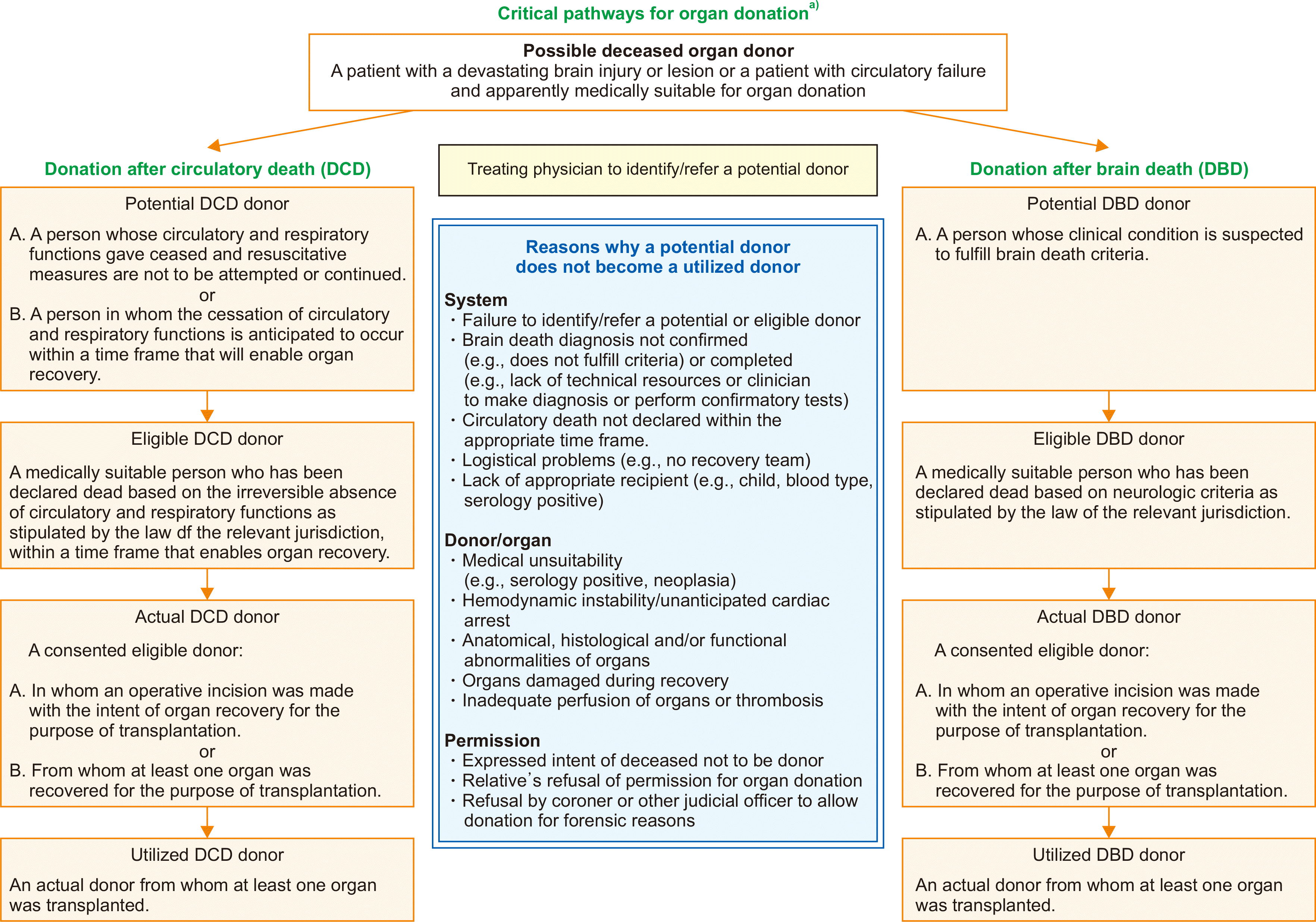
Fig. 2
A flowchart showing the study’s patient enrolment process and the calculation of the rate of possible organ donor detection. HSAJB, Hospital Sultanah Aminah, Johor Bahru; HQE, Hospital Queen Elizabeth; GCS, Glasgow Coma Scale; ICU, intensive care unit.
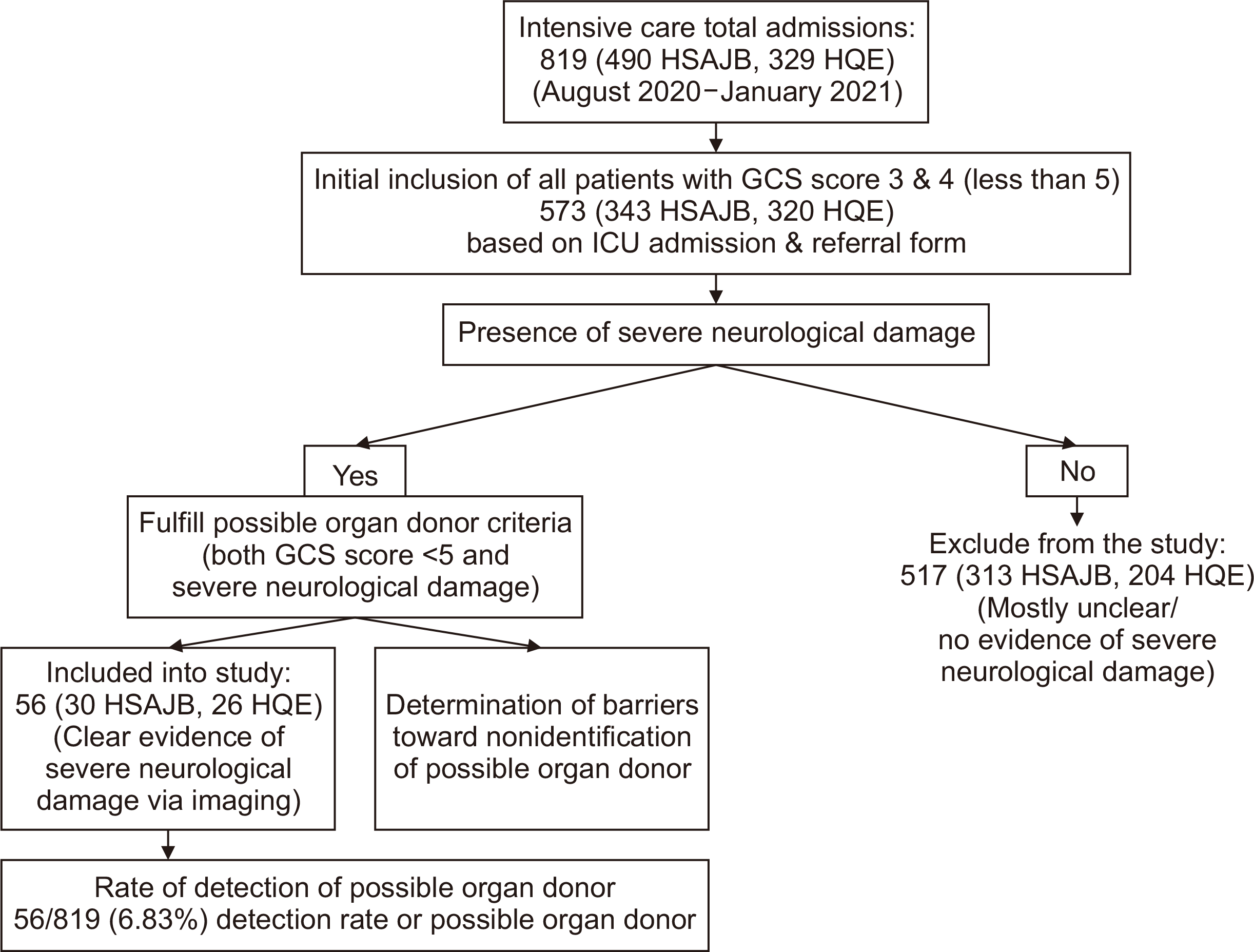
Fig. 3
A visual depiction of the barriers identified as preventing the identification of possible deceased organ donors among brain-injured patients admitted to the intensive care units of two major hospitals in Malaysia (Hospital Sultanah Aminah, Johor Bahru and Hospital Queen Elizabeth, Kota Kinabalu) over a 6-month period. Nonclinical barriers made up a larger proportion than clinical barriers (55% vs. 45%, respectively).
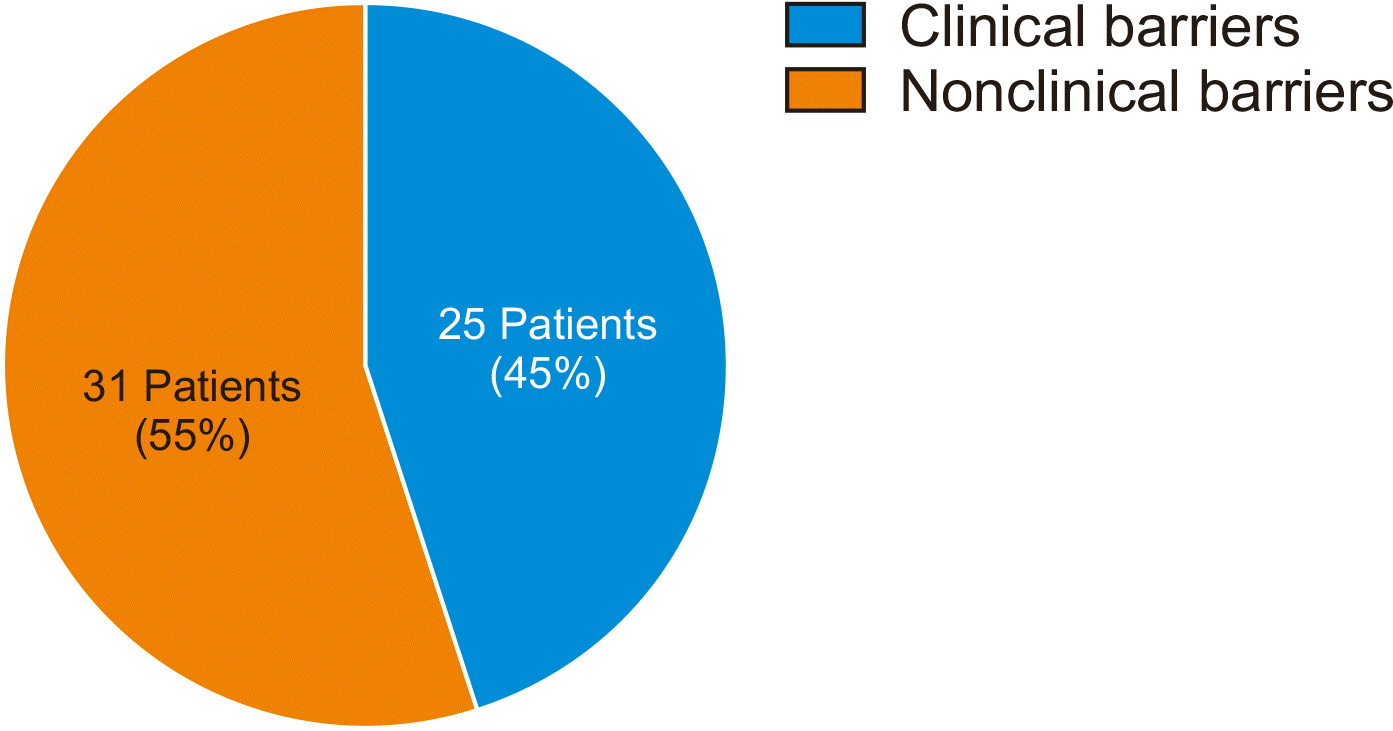
Fig. 4
Clinical barriers identified as preventing the identification of possible deceased organ donors among brain-injured patients admitted to the intensive care units of two major hospitals in Malaysia (Hospital Sultanah Aminah, Johor Bahru and Hospital Queen Elizabeth, Kota Kinabalu) over a 6-month period. Sepsis or unresolved infections were deemed by the intensive care doctors an important definitive reason for the nonreferral/nonidentification of brain-injured patients as possible organ donors. HIV, human immunodeficiency virus.
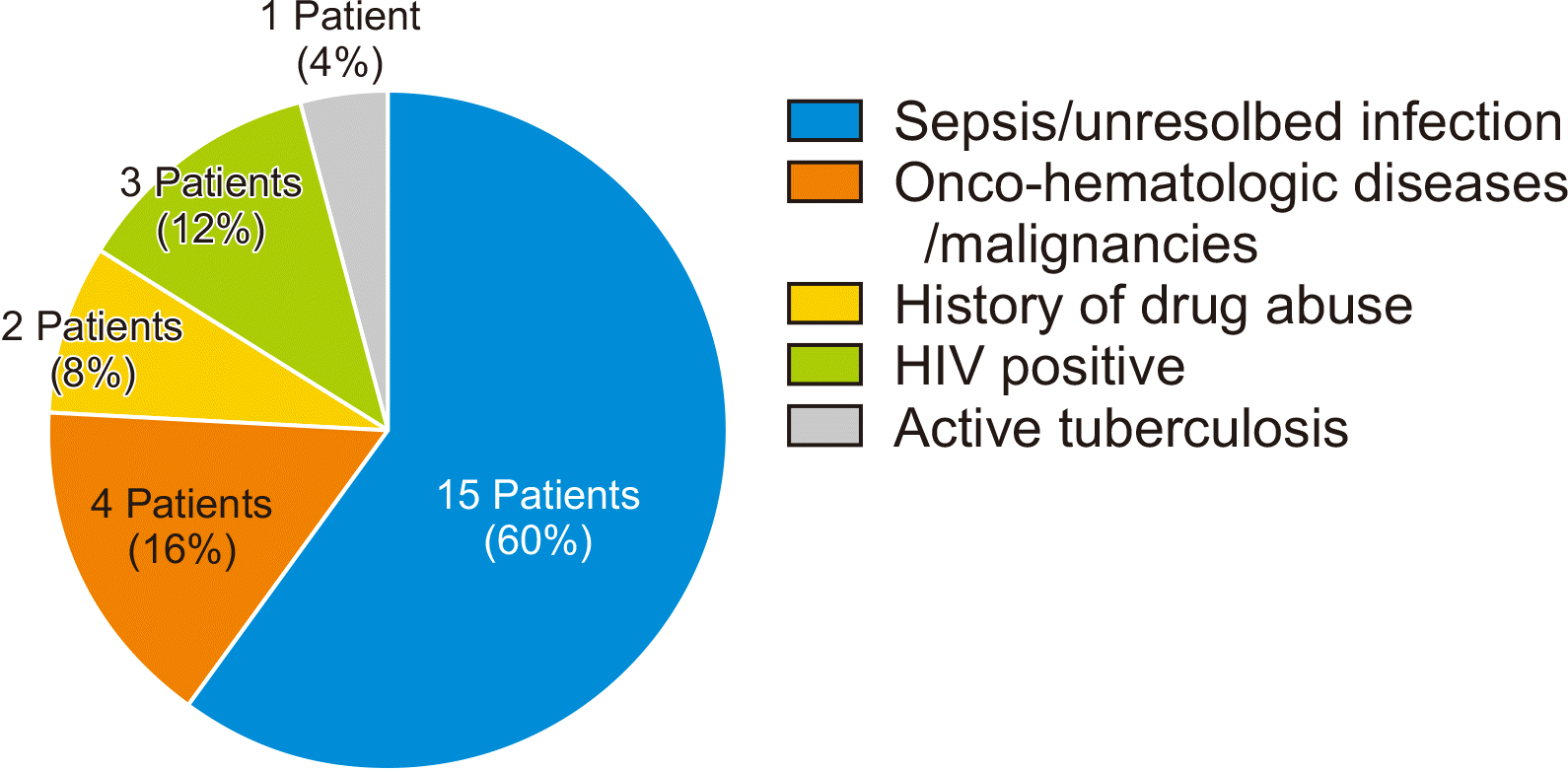
Fig. 5
Nonclinical barriers identified as preventing the identification of possible deceased organ donors among brain-injured patients admitted to the intensive care units of two major hospitals in Malaysia (Hospital Sultanah Aminah, Johor Bahru and Hospital Queen Elizabeth, Kota Kinabalu) over a 6-month period. The exact cause of nonidentification of possible organ donors among the patients was unable to be determined in 74% of cases, representing a very large proportion of potential loss of possible organ donors. The other (determined) causes were deemed potentially correctable if referred early to the hospital’s organ transplant coordinator.
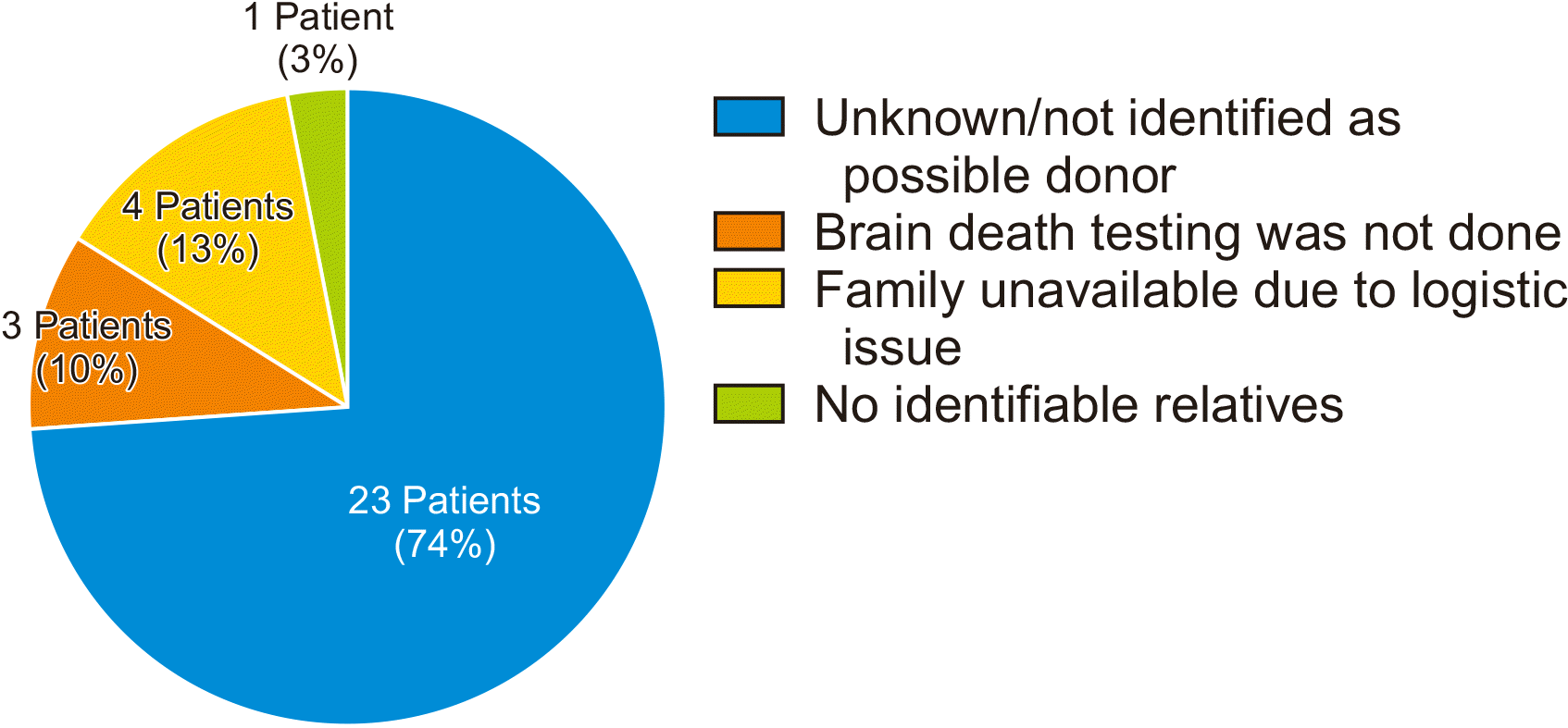
Table 1
Distribution of patients’ characteristics collected from August 2020 to January 2021 according to hospital




 PDF
PDF Citation
Citation Print
Print



 XML Download
XML Download